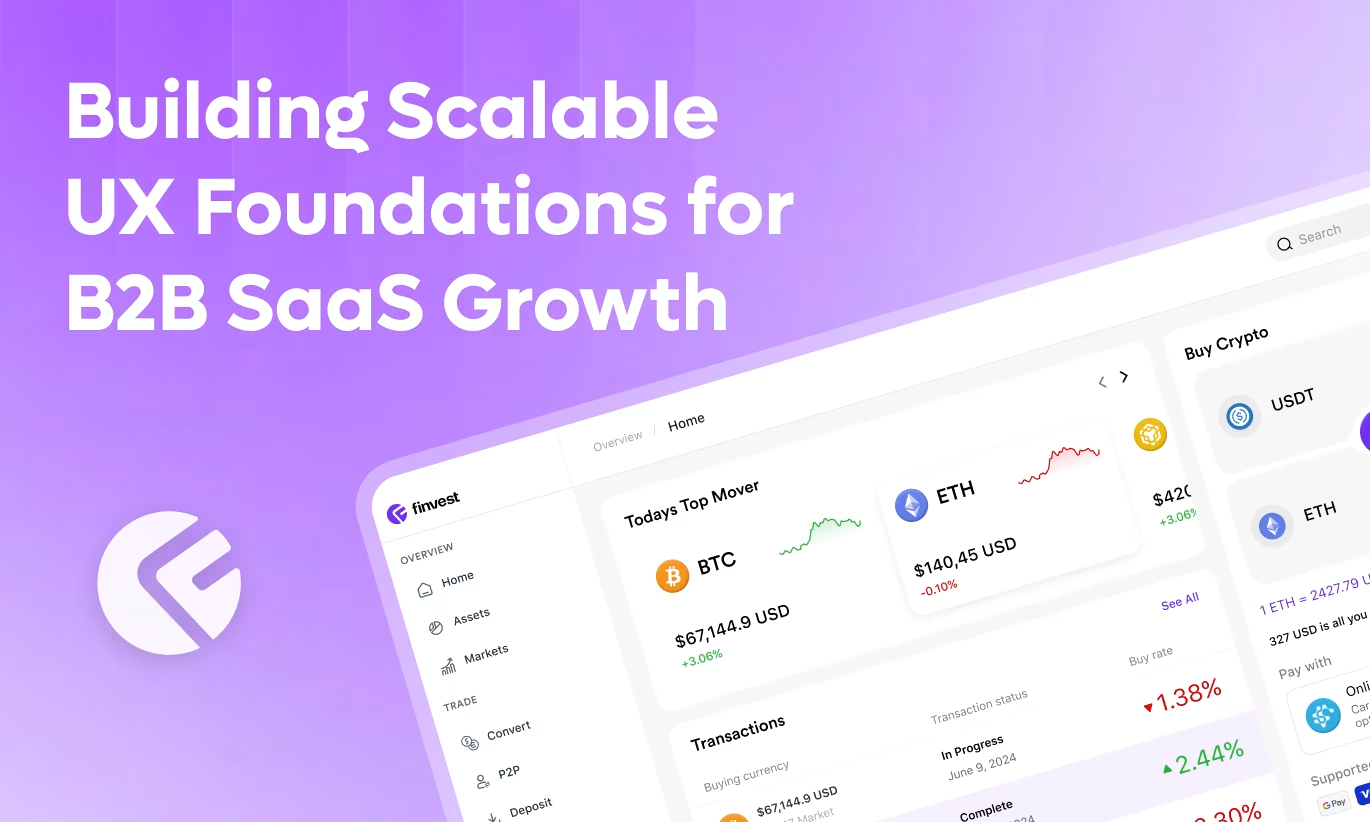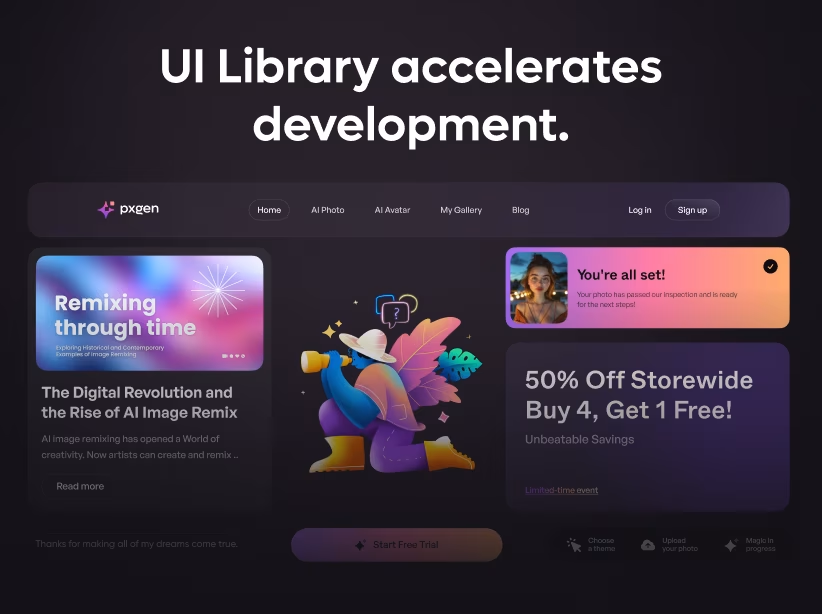Table of Contents
- Why UX Matters More for B2B SaaS Growth
- What Do We Mean by "Scalable UX Foundations"?
- Core UX Challenges in B2B SaaS Growth
- Best Practices for Building Scalable UX Foundations
- Emerging 2025 Trends in Scalable B2B SaaS UX
- Case Study: Scaling UX for SaaS Growth
- Steps to Build Scalable UX Foundations in 2025
- The Bottom Line: Scalable UX = Scalable Growth

In the B2B SaaS industry, growth doesn't come from features alone—it comes from experiences. A product packed with functionality but lacking usability can lose customers faster than it acquires them. In fact, 70% of B2B SaaS churn is linked to poor onboarding and confusing user flows.
That's why scalable UX foundations are critical. They ensure your product adapts to growth without losing consistency, clarity, or customer trust. For SaaS companies competing in a $300+ billion market (as of 2025), scalable UX is no longer optional—it's a survival strategy.
This article explores how to build UX foundations that scale with your product and customer base, backed by data, case studies, and practical design strategies.
Why UX Matters More for B2B SaaS Growth
Unlike consumer apps, B2B SaaS products are built for teams, not individuals. This means:
- Longer sales cycles
- Higher user expectations
- More complex onboarding
- Greater risk of churn if experiences fail
A Gartner report found that 77% of B2B buyers cite complexity as the biggest barrier to SaaS adoption. Scalable UX foundations simplify this complexity, helping products grow while retaining users.
What Do We Mean by "Scalable UX Foundations"?
Scalable UX foundations are the reusable design, research, and process frameworks that allow a SaaS product to evolve without reinventing the wheel.
They include:
- Design systems for consistent UI/UX patterns
- Onboarding frameworks that adapt to different customer roles
- Data-driven feedback loops to measure experience impact
- Accessibility standards that future-proof usability
- Cross-platform consistency for desktop, web, and mobile
Think of them as the structural DNA of your SaaS product—keeping everything coherent as you scale from 100 to 100,000 users.
Core UX Challenges in B2B SaaS Growth
- Complex Feature Sets $\rightarrow$ Users overwhelmed with dashboards full of options.
- Role-Based Journeys $\rightarrow$ Admins, managers, and end-users all require different flows.
- Scaling Teams & Customers $\rightarrow$ UX must support enterprise-level needs without alienating smaller clients.
- Global Expansion $\rightarrow$ Localization, accessibility, and compliance add layers of complexity.
Without scalable UX, SaaS companies end up with fragmented interfaces, high churn, and ballooning support costs.
Best Practices for Building Scalable UX Foundations
1. Start with a Flexible Design System
A design system isn't just a library of buttons—it's your product's visual and functional backbone.
- Benefits: Faster design cycles, reduced inconsistency, and easier scaling.
- Case Example: A SaaS HR platform reduced design debt by 40% after adopting a modular design system that supported both mobile and web.
Data shows that teams using structured design systems release new features 30–50% faster.
2. Prioritize User-Centered Onboarding
Onboarding is the single most critical moment for retention. In B2B SaaS, poor onboarding leads to up to 50% abandonment within 90 days.
Scalable UX onboarding strategies include:
- Interactive product tours
- Role-based onboarding flows
- Progressive disclosure (show advanced features later)
- Automated personalization powered by AI
Example: Orbix redesigned a SaaS analytics tool's onboarding, resulting in a 25% increase in adoption rate after simplifying role-based tutorials.
3. Embed Data-Driven Feedback Loops
Scalable UX thrives on iteration. Continuous research and analytics ensure designs evolve with customer needs.
- Tools: Heatmaps, NPS surveys, A/B testing, AI-driven sentiment analysis
- Benefit: Identify friction points early, reducing churn risk
McKinsey research shows SaaS products with structured feedback loops see 2.5x higher retention.
4. Design for Multi-Role Workflows
Unlike consumer SaaS, B2B platforms serve different roles—admins, managers, and team members.
Best practices:
- Map separate journeys for each role
- Provide dashboard customization
- Ensure permissions & access control are intuitive
Example: A project management SaaS Orbix worked with reduced support tickets by 30% after implementing role-specific dashboards.
5. Make Accessibility a Growth Priority
In 2025, accessibility is not just compliance—it's competitive advantage. With 26% of the global workforce requiring inclusive UX, scaling SaaS products must integrate WCAG standards, keyboard navigation, screen-reader compatibility, and localization.
Impact: Expands your potential customer base and avoids lawsuits while improving usability for all.
6. Invest in Micro-Interactions and Visual Feedback
Even in complex B2B products, small design details make big differences.
- Micro-interactions guide user actions
- Visual feedback reduces uncertainty in data-heavy dashboards
- Loading states improve perceived performance
Result: Products feel more polished, reducing frustration during daily usage.
Emerging 2025 Trends in Scalable B2B SaaS UX
- AI-driven personalization: Predictive UX that adapts to user roles in real time
- Voice & multimodal interfaces: Hands-free workflows for enterprise SaaS
- Dark mode ubiquity: Now considered a baseline feature, not a luxury
- Privacy-first UX: Building transparency into data collection and permissions
Case Study: Scaling UX for SaaS Growth
A B2B SaaS fintech startup partnered with Orbix Studio to improve scalability. Their challenge: fragmented dashboards and high churn among enterprise clients.
What we did:
- Built a modular design system in Figma
- Introduced AI-powered onboarding personalization
- Standardized accessibility compliance
Results:
- 40% faster feature rollout
- 22% increase in enterprise client retention
- 18% drop in support tickets within 6 months
Steps to Build Scalable UX Foundations in 2025
- Audit current design and UX processes $\rightarrow$ Identify duplication and inconsistency
- Establish a lightweight design system $\rightarrow$ Build on Figma or Webflow
- Define user journeys for key roles $\rightarrow$ Map workflows for admins, managers, and end-users
- Integrate continuous feedback loops $\rightarrow$ Test and iterate quarterly
- Bake accessibility from day one $\rightarrow$ Avoid retrofitting later
- Scale with AI tools $\rightarrow$ Use automation for research, prototyping, and personalization
The Bottom Line: Scalable UX = Scalable Growth
B2B SaaS growth is no longer just about building features—it's about building experiences that scale. By investing in UX foundations early, SaaS companies reduce churn, improve adoption, and accelerate global expansion.
At Orbix Studio, we've helped 120+ SaaS companies across fintech, healthtech, and enterprise software scale their products with future-ready UX design.
Fresh UI/UX Ideas, Straight to Your Inbox





